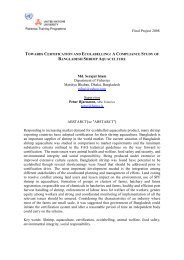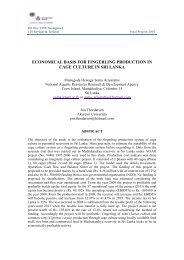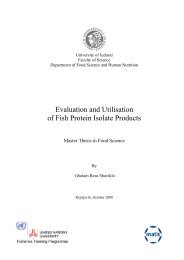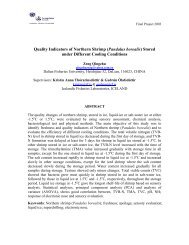Fish species abundance and distribution in The Gambia estuary
Fish species abundance and distribution in The Gambia estuary
Fish species abundance and distribution in The Gambia estuary
Create successful ePaper yourself
Turn your PDF publications into a flip-book with our unique Google optimized e-Paper software.
Darboe3 MATERIALS AND METHODS3.1 Organisation <strong>and</strong> composition of the survey missionsAn IRD river vessel “Diassanga” was used <strong>in</strong> all the cruise missions along the<strong>estuary</strong>. In most cases, the vessel sailed from the Senegalese delta village of Tubakutawith six Senegalese fishermen, an IRD mar<strong>in</strong>e eng<strong>in</strong>eer <strong>and</strong> a participat<strong>in</strong>g <strong>Gambia</strong>nmar<strong>in</strong>e ecologist who travelled to Dakar to receive <strong>and</strong> jo<strong>in</strong>tly endorse relevantdocuments perta<strong>in</strong><strong>in</strong>g to the respective mission at the IRD headquarters <strong>in</strong> Dakar. <strong>The</strong>signatures symbolically validated the contract for the conduct of the mission <strong>in</strong> the<strong>Gambia</strong> <strong>estuary</strong>. A more formal authorisation was usually provided by the M<strong>in</strong>istry of<strong>Fish</strong>eries through the Department of <strong>Fish</strong>eries. Each mission was well equipped <strong>in</strong>terms of researchers <strong>and</strong> equipment. <strong>The</strong> IRD research team jo<strong>in</strong>ed the follow<strong>in</strong>g day<strong>in</strong> Banjul to beg<strong>in</strong> at Chitabong bolong (Station 1). Two other <strong>Gambia</strong>n fishermenjo<strong>in</strong> their six Senegalese counterparts on the arrival of Diassanga <strong>in</strong> Banjul to jo<strong>in</strong>tlyconduct all sampl<strong>in</strong>g operations. On the whole, a team of six fisheriesscientists/ecologists conducted the study led by a renowned French researcher, Dr.Albaret who conducted several studies <strong>in</strong> the West African region particularly <strong>in</strong> theSene<strong>Gambia</strong> sub-region. Three other French researchers, a Senegalese specialist <strong>in</strong>Eco-sound<strong>in</strong>g <strong>and</strong> a <strong>Gambia</strong>n fisheries ecologist, as stated earlier, conducted the fivesurveys. Each survey usually took about 12 days <strong>and</strong> not more than five se<strong>in</strong><strong>in</strong>goperations were conducted daily.3.2 Sampl<strong>in</strong>g methodOne important aim dur<strong>in</strong>g sampl<strong>in</strong>g was to collect fish samples from the mouth to thefarthest extent of the <strong>estuary</strong>. <strong>The</strong>refore, the operation started around Chitabongbolong near Banjul, which was designated <strong>in</strong> most of the five surveys as station 1.<strong>The</strong> stations, which numbered to about 43, were established r<strong>and</strong>omly hence do notshow any def<strong>in</strong>ite pattern of <strong>distribution</strong> (Figure 2). However, some skewness wasallowed <strong>in</strong> the location of some stations, usually <strong>in</strong> or at the mouth of tributaries toallow capture of more diverse fish <strong>species</strong>. Sampl<strong>in</strong>g missions were conducted atdifferent times reflect<strong>in</strong>g marked hydrological periods of the year (ra<strong>in</strong>y season, dryseason, peak discharge period). Sampl<strong>in</strong>g was done us<strong>in</strong>g a purse se<strong>in</strong>e measur<strong>in</strong>g 250x 25 m with a stretched mesh size of 14 mm. <strong>Fish</strong> samples were sorted, identified to<strong>species</strong> level <strong>and</strong> recorded. <strong>The</strong> total numbers of <strong>in</strong>dividuals, as well as the totalweights of the <strong>species</strong> <strong>in</strong> the samples, <strong>and</strong> <strong>in</strong> some cases <strong>in</strong>dividual weights, wererecorded to the nearest 1 gm. In cases where the volume of the sample was too large,a r<strong>and</strong>om sub-sample of about 30-50 sorted <strong>in</strong>dividuals was taken for treatment.Treatment of <strong>in</strong>dividual <strong>species</strong> <strong>in</strong> each sample <strong>in</strong>cluded record<strong>in</strong>g of sexes,maturation stages of gonads <strong>and</strong> observation of stomach contents. Each <strong>species</strong> wasgiven a three-letter codification (FAO 1996).At each sampl<strong>in</strong>g station, physico-chemical parameters such as dissolved oxygen(DO), water temperature (T˚C), sal<strong>in</strong>ity (‰), station depth, <strong>and</strong> water transparencywere taken us<strong>in</strong>g oxygen meters, thermometers, refractometers, depth gauges, secchidisc <strong>and</strong> other equipment respectively.UNU – <strong>Fish</strong>eries Tra<strong>in</strong><strong>in</strong>g Programme 9
















